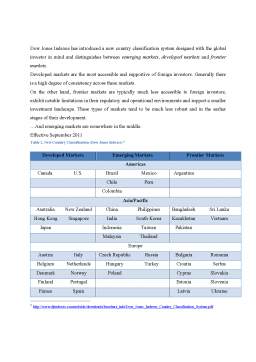Cuprins
- Chapter 1. The Financial Crisis 3
- 1.1. Introduction 3
- 1.2. Main Causes 3
- Chapter 2. Global Transmission of the Crisis 5
- 2.1. Effects 5
- 2.1.1. Toxic assets 5
- 2.1.2. Commodity bubble 6
- 2.1.3. Falling equity prices 7
- 2.1.4. Rising unemployment, increasing poverty 7
- Chapter 3. Emerging Markets 8
- 3.1. Definition and Classification 8
- 3.2. The impact of the financial crisis on emerging economies 11
- Chapter 4. What about China- 14
- 4.1. China and the financial crisis 14
- 4.1.1. Causes in an international background 14
- 4.1.2. Consequences 16
- 4.1.3. Responses to the crisis 16
- 4.2. Conclusions 19
- Refferences 20
Extras din proiect
Chapter 1. The Financial Crisis
1.1. Introduction
The financial crisis which the world is experiencing nowadays has become the worst in the last fifty years. Some analysts consider that its intensity is equivalent to that of the Great Depression of the 1930s. That crisis was the worst of modern times, and reflected previous excesses and subsequent incompetence. Although the comparison with the Great Depression is an exaggeration unjustified by the facts, the damage caused to the world economy is enormous. The complex and wide-ranging interaction between the financial world and the real economy as a result of the present turbulence already has begun to have serious consequences for the emerging economies, and the prospects for a fast recovery are more remote by the day.
1.2. Main Causes
The reasons for the current crisis are complex, but if we look back it’s not difficult to see where it came from and what its main causes are. For four years through the summer of 2007, the global economy boomed. Global GDP rose at an average of about 5 percent a year, its highest sustained rate since the early 1970s. About three-fourths of this growth was attributable to the emerging and developing economies. Inflation remained generally contained, even if with some upward pressures.
These developments led to the perception that the world economy was entering a new and prosperous stage. The value of financial and real assets was growing without a perceptible limit, and commodities had reached new and sustainable heights.
However, the prosperity was only an impression because behind of it there were hidden growing imbalances among the main economies of the world. The US, with low rates of savings, growing consumption rate and fiscal deficit, experienced increasing external current account deficits. These were financed by the surpluses of oil producing countries, China, Japan, and to a lesser extent Europe and Latin America. These imbalances grew rapidly, but markets did not respond significantly before 2007. The US dollar started to weaken in international markets and there were growing signs of impending problems. Moreover, as stated very precisely by Jack Boorman , these trends were further complicated by an increasingly integrated global trading and financial system which magnified and accelerated the transmission process; inadequate regulation and supervision of national financial systems and fragmentation of global regulation; weak surveillance by the IMF and other multilateral organizations; and aggravated by weak and uncoordinated policy responses to the initial signs of trouble in the financial system – responses that, as noted below, in many instances did more to shake confidence than to instill a sense that policy was up to the task of dealing with the banking system crisis and the impact on the real economy.
The immediate cause or trigger of the crisis was the bursting of the United States housing bubble which peaked in approximately 2005–2006. Steadily decreasing interest rates backed by the U.S Federal Reserve from 1982 onward and large inflows of foreign funds created easy credit conditions for a number of years prior to the crisis, fueling a housing construction boom. Loans of various types (e.g., mortgage, credit card, and auto) were easy to obtain and consumers assumed an unprecedented debt load. As banks began to give out more loans to potential home owners they encouraged debt-financed consumption. Consequently, housing prices bagan to rise. In the optimistic terms, banks would encourage home owners to take on considerably high loans in the belief they would be able to pay them back more quickly overlooking the interest rates. Once the interest rates began to rise in mid 2007, housing prices dropped significantly. In many states, like California, refinancing became increasingly difficult. As a result, the number of foreclosed homes also began to rise.
As part of the housing and credit booms, the number of financial agreements called mortgage-backed securities (MBS) and collateralized debt obligations (CDO), which derived their value from mortgage payments and housing prices, greatly increased. Such financial innovation enabled institutions and investors around the world to invest in the U.S. housing market. As housing prices declined, major global financial institutions that had borrowed and invested heavily in subprime MBS reported significant losses.
Preview document
Conținut arhivă zip
- The Financial Crisis and Emerging Markets.docx
































